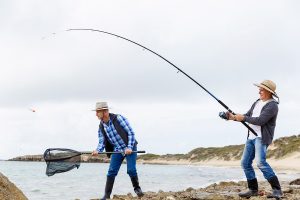Why do I need a baitcasting rod?
 Well the first reason you’re considering salmon casting rods is because you’re targeting Steelhead or Salmon. These fish are in rivers and streams during their life cycle and are extremely challenging and exciting to pursue in systems that are moving, such as rivers. Baitcasting rods are going to be the most effective ways to fish these species.
Well the first reason you’re considering salmon casting rods is because you’re targeting Steelhead or Salmon. These fish are in rivers and streams during their life cycle and are extremely challenging and exciting to pursue in systems that are moving, such as rivers. Baitcasting rods are going to be the most effective ways to fish these species.
Note: Remember when you’re shopping that the term baitcasting is interchangable with casting when it comes to these rods and reels.
The second reason you are looking for casting rods is because you’ve chosen a baitcasting reel as they have proven to be the most effective reels when fishing for those targeted species of fish in those bodies of water. These two factors will lead you to choose a rod that is equipped and most compatible with those particular methods of fishing and that type of gear.
How do I know what a casting rod looks like?
Salmon casting rods are made with a trigger type handle (similar to the stock of a rifle), where the reel sits on top of rod rather than below like a spinning reel. The line guides are also on top of the rod – of course – to allow for smooth casting from the reels eye, and decrease in diameter as the rod thickness decreases in diameter, until it reaches the tip where the smallest guide is located. The guides are visibly smaller then that of a spinning reel because they are allot more efficient when it comes to line release due to the bearings in the reel spool. A basic rule of thumb is – the more dramatic the action of the rod, the more eyelets needed to ease the friction of the line against the guide that could lead to a line snapping or worse a fish lost!
Get any “action” lately?
If you’re using a rod with fast action then chances are you’re in fast, big water possibly targeting big Chinooks or Sockeye with a big ol’ bouncing betty weight on the end. These fast action type casting rods bend mostly at the top 1/3 portion of the length. Moderate or medium action rods will bend closer to the middle of the rod and are more versatile rods that can be used as a “finesse” rod or “big water” rod. A slow action casting rod will bend right down to the handle and is very popular among steelhead and coho anglers that fish stealthy lures or smaller water.
Keep in mind while choosing your rod action that you’ll need to determine how much weight and how far you need to cast your lure. This will greatly effect how much action your rod should have. A fast action rod is very rigid or stiff compared to that of a slow action rod. It is because of the rigidity of the rod that you will be able to cast big weight out further than a slow action rod that id very lanky and absorbs more kinetic energy into the shaft that a more stiff casting rod.
What do I look for in choosing a well built casting rod?
- Nickel titanium guides (RECOIL??) are the best line guides but pricey. They do everything a ceramic guide does and more! Imagine bending your guide and it just pops back up again! Ya that’s right! The titanium also transmits more hits than you can shake a stick at (well almost).
- Ceramic guides are second best and work great with super lines or braided lines as they reduce wear. Try to avoid plastic line guides at all cost.
- Medium-Heavy or Heavy “power” rods are your best bet for salmon.
- Graphite or Carbon Fiber shaft is the premium shaft material with fiberglass bringing up the rear. Some rods are a combination of the two and work great as well.
- Quality resin – used on the guides
- Well built cork handle with a seat that fits your reel well.
- You get what you pay for!!
Quick tip:
The main objective of salmon casting rods is to get your lure or bait right down on the bottom of the stream. Steelhead and salmon that are migrating in streams and rivers are not very interested in eating. They are simply moving up the river to the spawning grounds and they generally strike out of instinct, curiosity, or to protect their turf. In order to get your line or lure where you want it though, the most effective rod is a baitcasting or “casting” rod while fishing for Steelhead or Salmon in rivers or streams, but anglers have been known to use the more traditional salmon spinning rods as well.
